#magnolia virginiana
Explore tagged Tumblr posts
Text
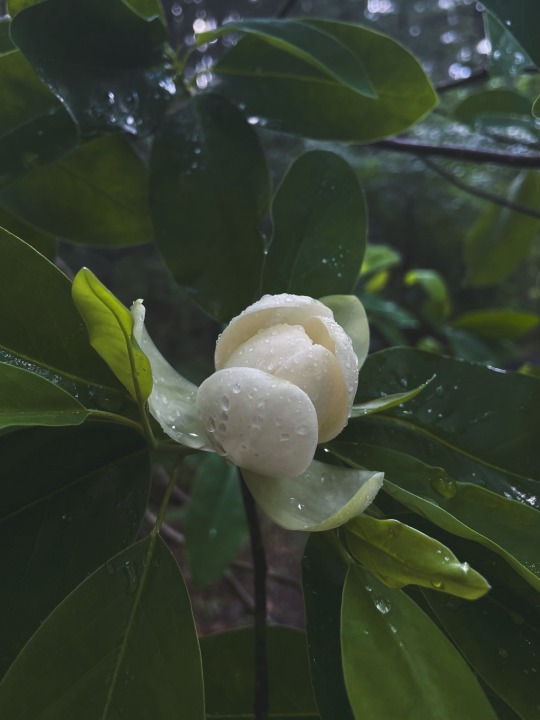
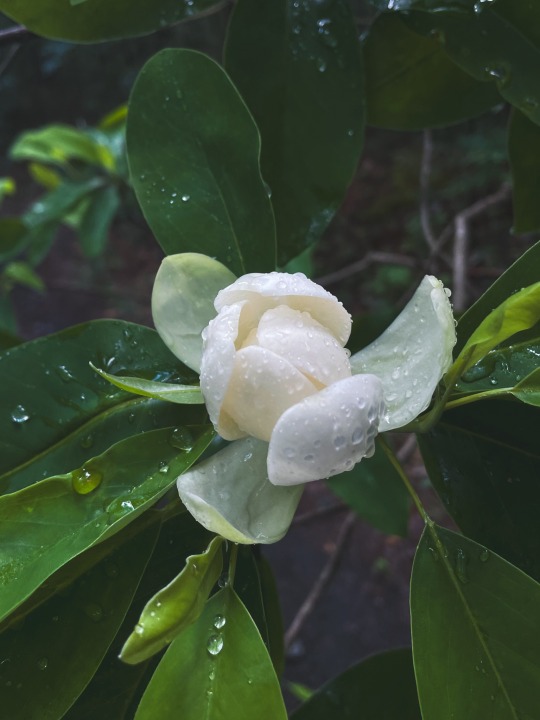
sweetbay magnolia.
#nature#flowers#magnolias#sweetbay magnolia#moody nature#magnolia virginiana#swamp magnolia#cedar swamp#these grow wild where i live and i love them EXTREMELY#my photos
14 notes
·
View notes
Text

Magnolia virginiana / Sweetbay Magnolia at the Sarah P. Duke Gardens at Duke University in Durham, NC
#Magnolia virginiana#Sweetbay Magnolia#Magnolia#Sweetbay#Laurel magnolia#Swampbay#Swamp magnolia#White bay#Beaver tree#Flowers#Native plants#Native flowers#Sarah p. Duke Gardens#Duke University#Durham#North Carolina#Edible plants#edible flowers#Durham NC
2 notes
·
View notes
Text

Renae Smith - Shadow Of Our Own Souls (2015)
#2015#flowers#nature#photography#Renae Smith#Shadow Of Our Own Souls#Magnolia virginiana#Sweetbay#Magnolia
1 note
·
View note
Text
Florida-Friendly Plants and Landscaping Ideas for Your Garden Design
Creating a beautiful and sustainable garden in Florida requires careful planning and selection of plants that thrive in the unique climate of the Sunshine State. Florida-friendly plants not only enhance the aesthetic appeal of your garden but also contribute to water conservation and support local wildlife. In this comprehensive guide, we will explore various Florida-friendly plants and landscaping ideas to help you design a stunning and eco-friendly garden.
Understanding Florida's Climate and Soil
Florida's climate varies from subtropical in the north to tropical in the south. The state experiences high humidity, frequent rain, and warm temperatures year-round, making it a haven for diverse plant life. Understanding the local climate and soil conditions is crucial for selecting the right plants for your garden.
Florida spans USDA hardiness zones 8-11. Knowing your specific zone helps determine which plants will thrive in your area. Florida soils range from sandy to clayey. Conduct a soil test to understand its pH level and nutrient content, which will guide your plant selection and soil amendment practices.
Benefits of Florida-Friendly Landscaping
Native plants are adapted to local rainfall patterns, reducing the need for supplemental watering.
Florida-friendly plants typically require less fertilizer, pesticides, and care compared to non-native species.
Native plants provide food and shelter for local wildlife, supporting biodiversity.
Deep-rooted native plants help stabilize the soil and prevent erosion.
Choosing Florida-Friendly Plants
Selecting the right plants is the cornerstone of a successful Florida-friendly garden. Here are some top ch
oices:
Trees
1. Southern Live Oak (Quercus virginiana): A majestic, long-lived tree that provides shade and supports wildlife.
2. Cabbage Palm (Sabal palmetto): Florida's state tree, known for its resilience and minimal maintenance.
3. Magnolia (Magnolia grandiflora): Offers beautiful, fragrant blooms and glossy leaves, ideal for ornamental use.
Shrubs
1. Saw Palmetto (Serenoa repens): A hardy, drought-tolerant shrub with fan-shaped leaves and white flowers.
2. Firebush (Hamelia patens): Attracts hummingbirds and butterflies with its vibrant red flowers.
3. Walter's Viburnum (Viburnum obovatum): A versatile shrub that can be used for hedges or as a specimen plant.
Creating a Florida-friendly garden involves more than just plant selection. Incorporate these landscaping ideas to enhance the beauty and sustainability of your garden:
Edible Landscaping
Combine aesthetics and functionality by incorporating edible plants into your garden design.
Fruit Trees: Plant fruit trees such as citrus, avocado, and fig, which thrive in Florida's climate.
Herb Gardens: Create an herb garden with rosemary, basil, oregano, and mint.
Vegetable Beds: Design raised beds or container gardens for growing vegetables like tomatoes, peppers, and leafy greens.
Butterfly Gardens
Attract butterflies and other pollinators by planting a variety of nectar-rich flowers and host plants.
Nectar Plants: Include flowering plants such as lantana, pentas, and butterfly bush.
Host Plants: Plant milkweed, passionflower, and fennel to provide food for caterpillars.
-Sheltered Areas: Create sheltered spots with shrubs and trees where butterflies can rest and lay eggs.
Practical Tips for Maintaining a Florida-Friendly Garden
Maintaining a Florida-friendly garden requires ongoing care and attention. Here are some practical tips to keep your garden healthy and thriving:
1. Water Wisely: Water plants early in the morning or late in the evening to reduce evaporation. Use rain barrels to collect and store rainwater for irrigation.
2. Fertilize Sparingly: Use organic fertilizers and compost to enrich the soil. Avoid over-fertilizing, which can harm plants and pollute waterways.
3. Prune Regularly: Prune plants to remove dead or diseased branches and encourage healthy growth. Follow proper pruning techniques to avoid damaging plants.
4. Monitor Pests: Keep an eye out for pests and diseases. Use integrated pest management (IPM) techniques, such as introducing beneficial insects and using natural remedies, to control pests.
5. Mulch: Apply mulch to conserve soil moisture, suppress weeds, and improve soil health. Replenish mulch as needed.
6. Weed Control: Regularly remove weeds to prevent them from competing with your plants for nutrients and water. Use mulch and landscape fabric to reduce weed growth.
Inspiring Florida-Friendly Garden Designs
To inspire your own garden design, here are some examples of beautiful and sustainable Florida-friendly gardens:
1. Tropical Paradise: Create a lush, tropical garden with a mix of palms, ferns, and colorful flowering plants. Add a water feature, such as a small pond or fountain, to enhance the tranquil atmosphere.
2. Coastal Retreat: Design a coastal-themed garden with salt-tolerant plants like sea oats, beach sunflower, and dune grass. Incorporate driftwood, shells, and a sandy path to complete the look.
3. Woodland Oasis: Transform a shady area into a woodland garden with native trees, shrubs, and groundcovers. Add a winding path, benches, and a birdbath to create a peaceful retreat.
4. Butterfly Haven: Plant a variety of nectar-rich flowers and host plants to attract butterflies and pollinators. Include a mix of colors and heights to create visual interest and provide food and shelter for butterflies.
5. Mediterranean Escape: Use drought-tolerant plants like lavender, rosemary, and olive trees to create a Mediterranean-inspired garden. Incorporate terracotta pots, gravel paths, and a seating area for a touch of elegance.
Conclusion: Creating Your Florida-Friendly Garden
Designing a Florida-friendly garden is a rewarding and sustainable way to enhance your outdoor space. By selecting the right plants and incorporating thoughtful landscaping ideas, you can create a garden that thrives in Florida's unique climate while conserving resources and supporting local wildlife. Whether you choose to create a tropical paradise, a coastal retreat, or a butterfly haven, your Florida-friendly garden will provide beauty and enjoyment for years to come.
0 notes
Text
Choosing the Right Tree for Your Yard: Factors to Consider and Popular Options
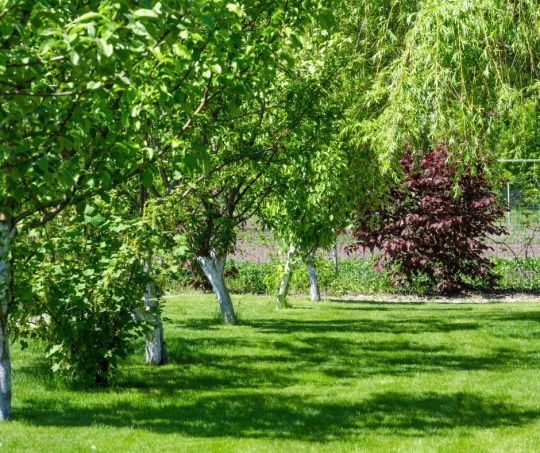
As a passionate gardener and tree enthusiast, I firmly believe that the right tree can transform your yard into a true oasis of beauty and tranquility. The tree you select not only adds visual appeal but also plays a crucial role in the overall health and functionality of your outdoor space. Whether you're looking to create a lush, shaded retreat, enhance your home's curb appeal, or provide a haven for wildlife, the choice of tree can make all the difference.
In this comprehensive guide, I'll share my expertise and guide you through the process of selecting the perfect tree for your yard. By the end of this article, you'll have the knowledge and confidence to make an informed decision that will bring lasting joy and value to your property.
Factors to consider when choosing a tree for your yard
Choosing the right tree for your yard requires careful consideration of several key factors. Here are the essential elements you should keep in mind:
Climate and Growing Conditions: Understanding the climate and growing conditions in your local area is crucial. Different tree species thrive in specific temperature ranges, precipitation levels, and soil types. Matching the tree to your region's climate will ensure its long-term success and vitality.
Available Space: Carefully measure the available space in your yard, taking into account the tree's mature size, including its canopy spread and root system. Selecting a tree that fits the allocated area will prevent overcrowding and potential damage to your property.
Desired Purpose: Consider the primary function you want the tree to serve, such as providing shade, enhancing privacy, or adding aesthetic value. This will guide you towards the most suitable species that can fulfill your specific needs.
Maintenance Requirements: Some tree species require more frequent pruning, pest management, or specialized care than others. Evaluate your willingness and ability to maintain the tree before making your selection.
Aesthetic Preferences: Personal preferences, such as leaf color, bark texture, and flowering characteristics, can also play a role in your decision-making process. Choose a tree that aligns with your desired visual appeal.
By carefully weighing these factors, you'll be well on your way to selecting the perfect tree that will thrive in your yard and meet your specific needs.
Popular tree species for different climates
One of the most crucial steps in choosing the right tree is understanding the various species that perform well in different climatic conditions. Here's a breakdown of some popular tree options for various regions:
Temperate Climates (e.g., Northeastern United States, Central Europe):
Oak (Quercus spp.)
Maple (Acer spp.)
Linden (Tilia spp.)
Birch (Betula spp.)
Beech (Fagus spp.)
Subtropical Climates (e.g., Southeastern United States, Southern Europe):
Live Oak (Quercus virginiana)
Crape Myrtle (Lagerstroemia indica)
Magnolia (Magnolia grandiflora)
Bald Cypress (Taxodium distichum)
Crepe Myrtle (Lagerstroemia indica)
Arid/Semi-Arid Climates (e.g., Southwestern United States, Mediterranean Region):
Mesquite (Prosopis spp.)
Palo Verde (Parkinsonia spp.)
Desert Willow (Chilopsis linearis)
Olive (Olea europaea)
Citrus (Citrus spp.)
Tropical Climates (e.g., Southern Florida, Hawaii):
Royal Palm (Roystonea regia)
Coconut Palm (Cocos nucifera)
Mango (Mangifera indica)
Banyan Tree (Ficus benghalensis)
Jacaranda (Jacaranda mimosifolia)
By familiarizing yourself with the tree species that thrive in your specific climate, you can make an informed decision that will ensure the long-term health and success of your chosen tree.
How to assess the health and condition of a tree
Before making your final selection, it's crucial to carefully evaluate the health and condition of the tree you're considering. Here are some key factors to assess:
Trunk and Bark: Examine the trunk for any signs of damage, cracks, or abnormal growths. The bark should be smooth and free of any unusual discoloration or peeling.
Branches and Foliage: Look for a balanced, symmetrical branching structure with healthy, vibrant leaves. Avoid trees with excessive dead or dying branches.
Root System: If possible, inspect the root system for any signs of damage or disease. Healthy roots should be firm, white, and free of any fungal growth or decay.
Overall Appearance: The tree should have a full, lush canopy and exhibit signs of active growth, such as new leaf buds or shoot development.
Professional Inspection: For added assurance, consider consulting with a certified arborist who can provide a comprehensive assessment of the tree's health and suitability for your yard.
By carefully evaluating these key factors, you can ensure that the tree you select is in optimal condition and well-suited to thrive in your yard.
Tree planting tips for optimal growth
Proper planting techniques are crucial for the long-term success of your chosen tree. Here are some essential tips to ensure your tree gets off to a strong start:
Site Preparation: Carefully select the planting location, ensuring it aligns with the tree's specific needs. Dig a hole that is two to three times the width of the root ball, but no deeper.
Root Ball Placement: Place the tree in the hole, making sure the top of the root ball is level with the surrounding soil. Avoid planting the tree too deep.
Backfilling: Gently backfill the hole with the original soil, avoiding the use of amendments or fertilizers at this stage. Lightly tamp the soil to eliminate air pockets.
Watering: Thoroughly water the tree immediately after planting, ensuring the soil is evenly moist but not waterlogged.
Mulching: Apply a 2-4 inch layer of organic mulch around the base of the tree, keeping it a few inches away from the trunk to prevent moisture buildup and rot.
Staking: If necessary, provide temporary staking to help the tree establish a strong root system and resist wind damage.
Ongoing Care: Continue to monitor the tree's water needs and adjust watering schedules as needed, particularly during the first year after planting.
By following these best practices, you'll give your newly planted tree the best possible start, setting it up for long-term health and growth.
Maintaining and caring for your chosen tree
Proper maintenance and care are essential for the long-term health and vitality of your tree. Here are some key considerations:
Pruning: Regularly prune your tree to maintain its shape, remove any dead or damaged branches, and promote healthy growth. Consult with a professional arborist for guidance on the appropriate pruning techniques and timing.
Watering: Ensure your tree receives adequate moisture, especially during periods of drought or extreme heat. Adjust watering schedules based on the tree's specific needs and local climate conditions.
Fertilization: Apply a balanced, slow-release fertilizer to provide the necessary nutrients for optimal growth. Avoid over-fertilizing, as this can lead to excessive foliage growth and weaken the tree.
Pest and Disease Management: Monitor your tree for any signs of pests or diseases and take prompt action to address any issues. Consult with a professional if you're unsure of the appropriate treatment methods.
Mulching: Maintain a 2-4 inch layer of organic mulch around the base of the tree, replenishing it as needed to retain moisture and suppress weed growth.
Seasonal Considerations: Adjust your care routine to accommodate the tree's seasonal needs, such as preparing it for winter dormancy or supporting new growth during the spring.
By diligently following these maintenance practices, you'll ensure your chosen tree thrives and continues to provide the desired benefits to your yard for years to come.
Common tree planting mistakes to avoid
To ensure the long-term success of your tree, it's essential to be aware of common planting mistakes and how to avoid them. Here are some pitfalls to steer clear of:
Planting too deep: Burying the tree's root flare too deep in the soil can lead to root rot and other health issues.
Improper soil preparation: Failing to loosen the soil or amend it properly can hinder root growth and establishment.
Inadequate watering: Under-watering or over-watering can both be detrimental to the tree's health.
Incorrect mulching: Applying mulch too deeply or too close to the trunk can cause moisture buildup and bark decay.
Lack of staking or support: Neglecting to provide temporary staking can result in unstable trees that struggle to establish a strong root system.
Transplanting at the wrong time: Choosing the wrong season or weather conditions for planting can put unnecessary stress on the tree.
Ignoring tree size and growth habits: Selecting a tree that is incompatible with the available space in your yard can lead to future problems.
By being mindful of these common mistakes and taking the necessary precautions, you'll give your tree the best possible start and set it up for long-term success.
Trees for specific purposes - shade, privacy, aesthetics
When choosing a tree for your yard, it's important to consider its intended purpose. Here are some recommendations for trees that excel in specific roles:
Shade Trees:
Oak (Quercus spp.)
Maple (Acer spp.)
Linden (Tilia spp.)
Elm (Ulmus spp.)
Sycamore (Platanus spp.)
Privacy Trees:
Evergreen Trees (e.g., Spruce, Fir, Pine)
Arborvitae (Thuja spp.)
Leyland Cypress (x Cupressocyparis leylandii)
Eastern Red Cedar (Juniperus virginiana)
Bamboo (Bambusoideae spp.)
Aesthetic/Ornamental Trees:
Flowering Trees (e.g., Cherry, Dogwood, Magnolia)
Japanese Maple (Acer palmatum)
Crape Myrtle (Lagerstroemia indica)
Redbud (Cercis canadensis)
Serviceberry (Amelanchier spp.)
By aligning your tree selection with your specific needs and preferences, you can create a visually stunning and functional outdoor space that enhances your property's overall appeal.
Consulting with a professional arborist for tree selection
While this guide provides a wealth of information to help you make an informed decision, there's no substitute for the expertise of a professional arborist. Consulting with an arborist can be invaluable in the tree selection process. Here's why:
Tailored Recommendations: Arborists have in-depth knowledge of local climate, soil conditions, and the specific needs of various tree species. They can provide personalized recommendations that are perfectly suited to your yard and growing environment.
Comprehensive Assessments: Arborists can conduct a thorough evaluation of your property, taking into account factors such as available space, existing vegetation, and potential challenges. This holistic approach ensures you choose the right tree for your unique situation.
Planting and Maintenance Guidance: Experienced arborists can offer expert advice on proper planting techniques, ongoing care and maintenance, and strategies for addressing any issues that may arise.
Long-Term Planning: Arborists can help you develop a comprehensive, long-term plan for your yard, factoring in the growth and maturity of your chosen tree species to ensure a harmonious and sustainable landscape.
By partnering with a professional arborist, you can have the peace of mind that comes with knowing you've selected the perfect tree for your yard. Contact a certified arborist in your area today to get started.
Choosing the right tree for your yard is a decision that can have a lasting impact on the beauty, functionality, and overall value of your outdoor space. By considering the factors outlined in this guide, you'll be well on your way to selecting a tree that will thrive and provide countless benefits for years to come.
Whether you're looking to create a shaded oasis, enhance your home's curb appeal, or attract more wildlife, the perfect tree is out there waiting for you. With a little research, careful planning, and the guidance of a professional arborist, you can transform your yard into a true sanctuary that you and your family will cherish for generations.
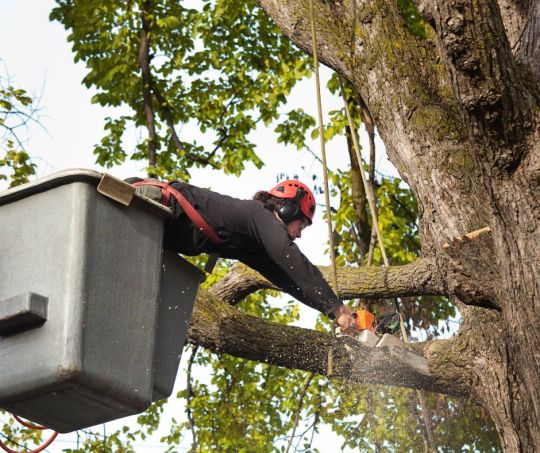
Selecting the right tree service company and arborist in Belle Meade, TN, requires careful consideration to ensure the health and longevity of your trees. Begin your search by examining the credentials and experience of potential candidates. Look for certifications from respected organizations such as the International Society of Arboriculture (ISA) and the Tree Care Industry Association (TCIA). These certifications indicate a commitment to industry standards and ongoing education, ensuring that the arborist you choose is well-equipped to handle the complexities of tree care.
Insurance and licensing are also essential factors to consider. Confirm that the company holds appropriate insurance coverage and is licensed to operate in your area. This protects you from liability in the event of accidents or property damage during the course of the work.
Evaluate the range of services offered by each tree care company. Ideally, you'll want to choose a provider that offers a comprehensive suite of services, including tree pruning, removal, stump grinding, and tree health assessments. A company that can address all of your tree care needs will save you time and hassle in the long run.
Consider the company's approach to tree care, including the techniques and equipment they use. Modern, well-maintained equipment and environmentally friendly practices demonstrate a commitment to safety and sustainability. Additionally, inquire about the arborist's knowledge of local tree species and their expertise in diagnosing and treating common tree ailments.
Customer reviews and referrals can provide valuable insights into the reputation and quality of a tree service company. Ask for references and inquire about past projects similar to yours. Transparent communication and detailed estimates are also crucial. A reputable company will provide clear explanations of the proposed work and a breakdown of the associated costs.
Ultimately, choose a tree service company and arborist that instills confidence through their expertise, professionalism, and dedication to the health and well-being of your trees in Belle Meade, TN. By taking the time to research and vet potential candidates, you can ensure that your trees receive the care they deserve.
Moore & Smith Tree Care LLC 301 S Perimeter Park Dr #100, Nashville, TN 37211, United States (615) 877-8733 https://nashvilletntreeservice.com/
0 notes
Text
Magnolia virginiana Sweet bay magnolia
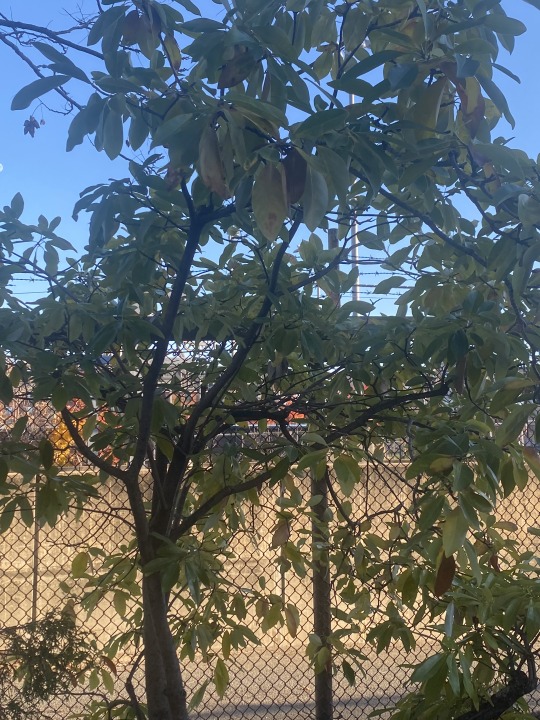
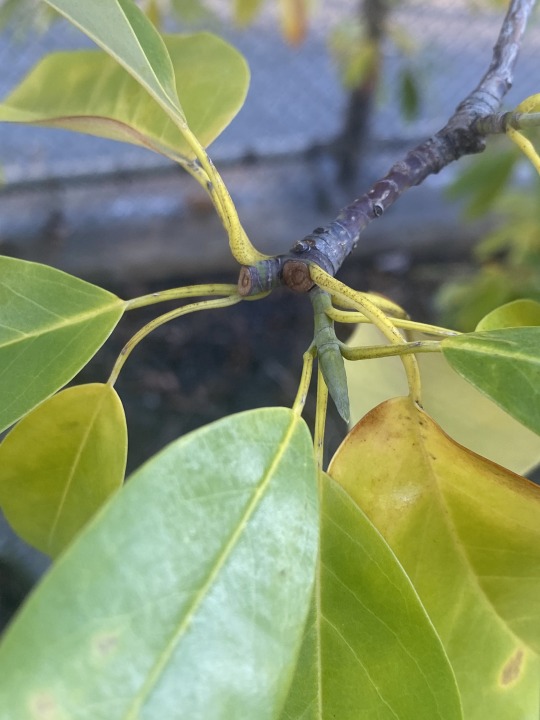


This tree was photographed at Northeastern University's arboretum near the Gainsborough garage. As you can see, the leaves are still very green and waxy, indicating that it seems to be changing color very late. There are also buds at the end of one of the branches which I did not see on any of the surrounding trees.
Basic facts
This tree is native to Eastern United States with a cold hardiness zone of 5 to 10. The tree can grow between 10 to 35 feet in height and the same in spread. This tree prefers full sun to part shade, medium to wet water, and rich organic soils. This tree can also toleration wet, boggy soils. You can expect to see this species near the Atlantic Coast of New York
Design
This tree has beautiful white flowers that bloom in May to June as well as showy fruit. This means you can expect to see these flowers in late spring and well into summer. Because of this, consider adding this tree as an element to extend the beauty of your garden past spring. Depending on the climate, the foliage can be evergreen to semi evergreen, so the waxy green leaves can be seen year round. However, in colder climates expect a fully deciduous tree.
Bird Attraction
This tree produces a cone-like fruit with bright red seeds that attract all sorts of birds. These birds are: woodpeckers, tanagers, grosbeaks, cardinals, and finches. Because of the wide range of birds that this tree can attract, it adds wildlife value to any community it is in. It can also be used to purposely attract birds to your garden in August to September
Sources
https://www.missouribotanicalgarden.org/PlantFinder/PlantFinderDetails.aspx?kempercode=e110
https://nc.audubon.org/news/sweetbay-magnolia-adding-life-your-garden#:~:text=Great%20for%20Birds&text=The%20fruits%20will%20attract%20a,only%20to%20our%20coastal%20plain.
0 notes
Text
Nature's Beauty Restored: How to Safely and Efficiently Treat Magnolia Scale
The Magnolia is a beautiful tree with blooms as big and bright as the leaves on its thick, lush branches. However, Magnolias are also unfortunately prone to infestation by the Magnolia scale. They feed on the sap of Magnolia trees, causing significant damage to the tree if left untreated. This feeding can cause extensive damage to the tree, including dieback of branches, leaf yellowing, drop, and stunted growth. In severe cases, Magnolia scale infestation can even kill the tree.
The first indication of Magnolia scale infestation is generally the formation of tiny, white pimples on the tree’s leaves or branches. These bumps are actually the insects themselves, and you can easily crush them between your fingers. You may also notice black sooty mold growing on the tree, which is a sign of sap dripping from the feeding insects.
Magnolia scale is a severe problem for many types of Magnolia trees. The insect sucks the sap from the tree, which can lead to branch dieback, leaf drop, and even tree death. Predators such as ladybugs will eat them, but in large numbers, Magnolia scales can create an immense problem for an entire tree.
The adult Magnolia scale is a hard, brownish-black shell that covers the entire body. Underneath this hard shell is a white, fleshy body that is attached to the tree. The scales are about 1/4 inch long and can be found on the stems and leaves of Magnolia trees.
About Magnolia Scale Infestation
Magnolia scale (Neolecanium cornuparvum) is a serious agricultural pest in the southeastern United States. This red and black armored scale insect first attacks young tender shoots, preventing the growth of new leaves, flowers, and fruit. As the infestation continues, it may spread to twigs and stems, causing the tree to decline and die.
Young trees are often the entry point of the Magnolia scale infestations. You can eliminate them by treating heavy infestations of scale during late summer as the overwintering eggs hatch and before they emerge from their protective winter covering. However, older trees with larger populations may need chemical treatment to control the scale.
Hosts Of Magnolia Scale
You will commonly find Magnolia scale on sweetbay Magnolia (Magnolia virginiana), cucumbertree Magnolia (M. acuminata), and southern Magnolia (M. Grandiflora). However, it has also been known to infect other trees in the genus Magnolia, as well as holly (Ilex spp.), birch (Betula spp.), and several other plant species.
Magnolia scales are known as a “soft scale.” which means that it does not have hard shell-like other scale insects. They usually reside on the underside of leaves, where it feeds on sap from the tree’s vascular system. It can weaken and eventually damage the tree, as well as cause discoloration or browning of the leaves.

Symptoms and Effects of Magnolia Scale
Symptoms Of Magnolia Scale Infestation
The most common symptom of a Magnolia scale infestation is the appearance of small, white bumps on the leaves of the tree. As the infestation progresses, these bumps will turn brown and eventually black. The scale insects secrete a waxy substance that covers their bodies and protects them from predators and the elements. This substance can also make it complex to identify scale infestations until they are well established.
Another symptom of Magnolia scale infestation is the presence of sooty mold on the leaves. Sooty mold is a black fungus that grows on the honeydew secreted by the scale insects. The presence of sooty mold can cause the leaves to turn yellow and eventually drop off.
Effects Of The Invasion On Infected Trees
Magnolia scale is a serious pest of Magnolia trees. Infested trees may have yellowish leaves, dying twigs, and produce fewer flowers. In case of heavy infestations, scale insects and sooty mold will completely cover the tree. However, this can weaken and even kill the tree.
Magnolia Scale Infestation: How To Get Rid Of It
For large infestations of Magnolia scales, it is best to contact a professional tree contractor for assistance. However, if the problem is small enough, you can take steps yourself to control the Magnolia scale. Spray the trees with injections during cool weather months when the insects are overwintering and not feeding actively. Another option is to use a systemic insecticide for scale insects that can be applied in late winter or early spring when the scales are still dormant. This type of chemical will prevent the bugs on the Magnolia tree from feeding and causing damage to the tree for about two months, so you must reapply them regularly.

Tips To Prevent Magnolia Scale Infestations
To prevent Magnolia scale infestations, it is crucial to maintain healthy trees by practicing proper care and maintenance. It includes watering the tree regularly, fertilizing it with a nutrient-rich fertilizer, and treating any dead or damaged branches. Additionally, you can protect your Magnolia trees from damage by using broadleaf insecticides carefully and in moderation. If you notice a Magnolia scale infestation on your tree, ensure to treat it promptly and carefully to prevent further damage and loss.
There are a few different approaches to Magnolia scale treatment, depending on the severity of the infestation and species of Magnolia tree. For moderate infestations, a product containing neem oil can be used to control Magnolia scale populations and minimize the damage done to your Magnolia tree.
The best way to control the Magnolia scale is to keep an eye out for the early signs of infestation and treat the tree with a pesticide before the scales have a chance to lay their eggs. You can also encourage predators such as ladybugs to eat the scales.
If Magnolia scale infestation is more severe, you may need to take more drastic measures, such as treating affected branches or even the entire Magnolia tree. However, with proper Magnolia tree scale treatment, you can keep your Magnolia healthy and beautiful for years to come. So, if you notice any signs of Magnolia scale infestation, be sure to reach out to a local expert right away for help in getting your tree back on track.
Ways To Promote Healthy Growth And Restrict Entry Of Magnolia Scale
The best way to manage the Magnolia scale is to keep your tree healthy and vigorous. It will make the tree less attractive to scales and reduce the possibility of a damaging infestation. To promote healthy growth in your Magnolia tree, water it regularly and fertilize it with a nutrient-rich fertilizer. You should also treat any dead or damaged branches to keep the tree strong and healthy.
In addition to promoting healthy growth, you can also take steps to restrict the entry of the Magnolia scale onto your property. You can do this by sealing any cracks or crevices in buildings and fences where the insects might enter. You should also inspect any trees or shrubs before bringing them onto your property and remove any Magnolia scales that you find.
If you notice an infestation of Magnolia scale on your tree, it is crucial to treat it promptly in order to prevent further damage. You can do this with a variety of methods, including physical removal, chemical pesticides, and biological agents such as ladybugs. Working with a local tree care expert can help you choose the best approach for your Magnolia and restore it to health. However, with proper care and maintenance, you can promote healthy growth in your Magnolia tree and protect it from Magnolia scale infestations.
Original Source: Everything About Magnolia Scale Infestation & Treatment
#magnolia scale#magnolia scale treatment#tree disease#tree treatment#tree service#tree care#pest control
0 notes
Note
📂📂📂📂📂📂📂
Elbas Islanders I promised and Elbas Islanders you shall get! This bunch is all tree people but about half of the total population is mushroom people. Both species live for 150-200 years so if some of these ages seem weird, that's why. (I also totally borrowed from your folder ask format because I thought it worked well.)
I realized I never introduced the current Council for realsies so here they are first:
Milo Elviret
45, he/him, magnolia (Magnolia virginiana)
Lead Councillor and legal compliance chair; grandkid of one of the island's founders
Would be a lawyer on the mainland if he'd actually taken the bar exam instead of becoming a legal compliance officer for a research airship and then moving to Elbas, where he immediately got swept up in its legal and philosophical history. Lives with Binna, his best friend and fellow flower gardener, and her dad. Extremely fond of cookies.
Ellery Bastien
46, he/him, fringetree (Chionanthus virginicus)
Logistics chair and treasurer; Vinnek's kid and Nidilaenn's queerplatonic partner
Typically seen in babydoll dresses but his closet contains multitudes that he couldn't bear to part with after moving back to Elbas from the mainland. Constantly a little sharp and critical, with infinite capacity for sarcasm, but also the kind of person who always keeps his word. Lives on one side of a divided house with Nidilaenn on the other.
Nidilaenn Archimbault
47, they/them, redbud (Cercis canadensis)
Maritime chair and secretary; Ellery's queerplatonic partner
Loves all things sailing and has acted as the island's unofficial ferrier for years. Has never had a comfortable trip to the mainland because of their strong sensitivity to scents, but wants to one day visit their dad out in the Vale. Also wonders if wearing a bikini top as your only top is the kind of thing that gets you weird looks in the Vale.
Tirias Nenatopol
51, she/he, sweetgum (Liquidambar styraciflua)
Custodial chair; Ysa's live-in partner
A measly 6' 7", making her the second-tallest person on the island. Can't speak vocally but is quite talkative (and flirtatious, though really only with her partners). Her pride and joy are the secondhand paint coloring and mixing machines her sister sent over from the mainland.
Patience Gaenlan
94, she/they, dogwood (Cornus florida)
Social services chair; co-manager of the island's nonroot hotel
Connected to Elbas through her wife, Mel, who she met in the course of being an activist organizer on the mainland. Is blind and navigates with a purple cane she sometimes jokingly compares to Mel, who is a mushroom person and therefore also purple. Has swirling carvings from left wrist to chin, the result of many decades of carving and healing.
And now some related characters:
Vinnek Bastien
72, they/them, fringetree
Archivist; Ellery's parent
Wearer of massive rimless glasses and t-shirt dresses. Connoisseur of all things Calennec, Dez's favorite cartoon/comic character. Currently going through personal winter and slowly losing all their leaves.
Ysa Tilly
55, thon/thon, tulipwood (Liriodendron tulipifera)
Pub bartender and manager; Tirias's partner
Seven feet tall, with a thick build to match. Used to bartend with actual alcohol back on the mainland, but now serves mostly people who drink anything but (thonself included). Thons showmanship and liquor bottle collection haven't gone away though.
#the Councillors are elected but can basically stay in their seats forever if they don't quit or get voted out#Patience has been renewed on the Council for over a decade because she takes no shit and is Best Server Admin#custodial chair responsibilities are why Tirias is always doing home improvement stuff. as though she wouldn't otherwise#bonus fact: Ysa ended up not being a himbo character but was originally kinda based on Kronk#rose brambles#ask games#folder ask game#wip: tfa#c: Milo#c: Ellery#c: Vinnek#c: Nidilaenn#c: Tirias#c: Patience#c: Ysa
1 note
·
View note
Photo

@headspace-hotel Native plants from friends and local plant sales! The row on the right is umbrella magnolia (Magnolia tripetala), wild strawberry (Fragaria virginiana), beardtongue (Penstemon laevigatus), and wild bergamot (Monarda fistulosa)
Box on the left is green and gold (Chrysogonum virginianum), eastern columbine (Aquilegia canadensis) , oakleaf hydrangea (Hydrangea quercifolia), and devil’s walking stick (Aralia spinosa).
Plenty left on the list I need to find, but these will be a good start to get the natives spreading. Already have solomons seal planted as well, among some nice natives present already. Going to turn this yard into a native haven.
1 note
·
View note
Text
Magnolia virginiana
La Magnolia virginiana es un árbol deciduo nativo de América del Norte que se caracteriza por sus grandes flores perfumadas... http://dlvr.it/SjSZHj
0 notes
Photo






Magnolias
Practically a staple of the South.
#sweetbay magnolia#Magnolia virginiana#Nikon D3400#Plantae#Angiosperms#Magnoliids#Magnoliales#Magnoliaceae#Magnolia (genus)#trees of the Southeastern United States#garden plants of North America#bird food plants#ornamental trees#trees of the United States#flora#trees of the Eastern United States#trees of the Northeastern United States
3 notes
·
View notes
Text
An swallowtail guy on my Magnolia virginiana pretends to be a snake very convincingly!!
69 notes
·
View notes
Text
Plants native to Georgia (state) that look cool / helpful
Aesculus pavia
Bignonia capreolata
Callicarpa americana
Cercis canadensis
Cephalanthus occidentalis
Cornus florida (babies?)
Euonymus americanus
Gelsemium sempervirens
Hydrangea quercifolia
Ilex decidua
Illicium floridanum
Ilex glabra
Ilex opaca
Ilex verticillata
Ilex vomitoria
Juglans nigra (BABIES)
Liriodendron tulipifera
Lonicera sempervirens (AHAHA)
Magnolia grandiflora
Morella cerifera
Parthenocissus quinquefolia
Quercus alba (one [1] baby)
Quercus coccinea
Quercus falcata
Quercus nigra
Quercus phellos
Quercus shumardii
Quercus virginiana
Vaccinium arboreum
Viburnum acerifolium
Wisteria frutescens
4 notes
·
View notes
Photo

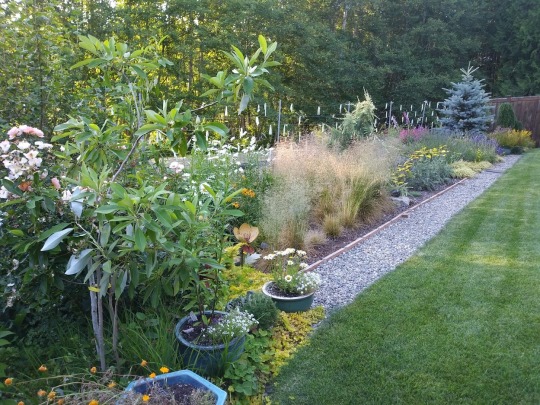
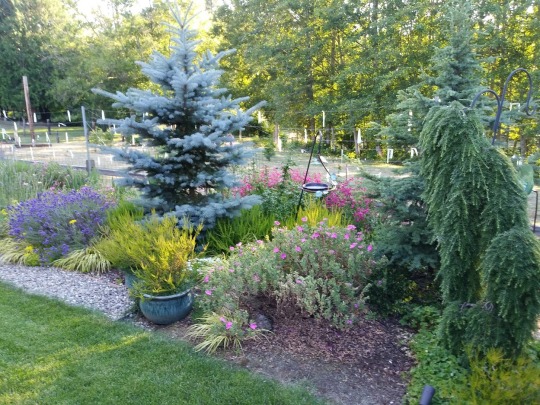
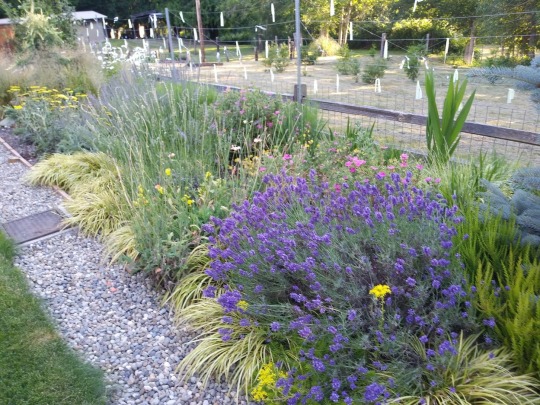
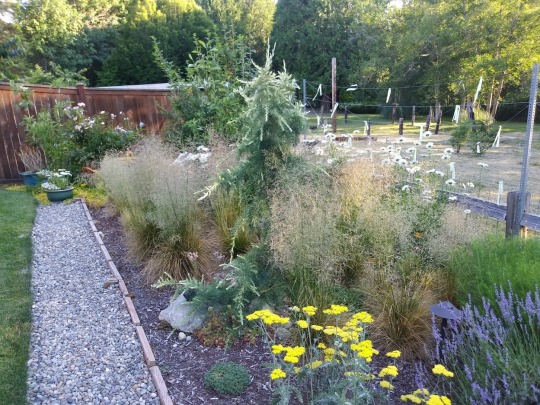

Our BACK Garden - many photos have been posted featuring the small Flower Garden on the south side of the house. This posting is for the entire BACK Garden, just an overview.
1. The back of our house, which faces due west. Photo taken last evening from the Upper Meadow part of our neighborhood forest restoration project. That’s the Back Porch up above, beneath which is a bench seat, shade garden, and a bunch of pots. On the right up against the wall is the Flower Garden. And, in front, behind the split-rail fence that separates all our homes from the forest project, is the “Back Garden”.
2. Overall view of the Back Garden, 60′ x 10-12′ extending south to north along the west side of the lot. That’s a gravel Infiltration Trench along the inner side, which collects rainwater from the roof and allows it to soak into the groundwater table. The CONCEPT of the Back Garden was developed by both of us, working together for a change, just as we did with the Japanesque Front Garden. The idea was to create a garden that related to the meadow beyond the fence, but that could also house a number of larger plants we brought from our former home in Bothell, WA. So it starts at one end with a riparian zone, spreads into a prairie, that interblends with Mediterranean plants, and ends in an alpine zone.
UPPER - the “Alpine” features a smaller-growing Baker’s Colorado blue spruce (Picea pungens ‘Bakeri’), a light green Mountain hemlock (Tsuga mertensiana), and an upright-trained ‘Thorson’s Weeping’ Western hemlock (Tsuga heterophylla cultivar). There are also shrubs: colorful-foliaged summer heathers (mainly Calluna vulgaris ‘Firefly’), a rockrose, several smaller growing forms of mahonia, a Himalayan blueberry, a Crandall currant (fragrant, yellow-flowered hybrid of the Intermountain West native Ribes odorata), HUGE bushy hybrid penstemon - Garnet and Firebird, and underneath the hemlocks - the tall ground-cover Big Sur manzanita (form of Arctostaphylos edmundsii).
UPPER MIDDLE - the “Mediterranean” features magenta-flowered Sunset rockroses (Cistus x pulverulentus), various English and French lavenders, a mass of chrome yellow Moonshine yarrow, and a mass of variegated purple moor grass (Molina caerulea ‘Variegata’) interplanted with various crocosmias.
MIDDLE - the “Prairie” - this is the largest part of the garden, melding into the Mediterranean garden on the north. This features double curving bands of Rudbeckia fulgida ‘Early Bird Gold’ and Becky Shasta Daisy, clumps of standard purple moor grass, white yarrow, purple Verbena bonariensis, Russian sage (Perovskia atriplicifolia), a whale-shaped mass of variegated Northern hairgrass (Deschampsia caespitosa), blending into a mass of billowing Arkansas blustar (Amsonia hubrechtii). And...at the juncture with the Mediterranean garden is a “weeping” Deodar cedar, probably Snow Sprite, planted in a mound of rocks with penstemon, sedums, and sempervivums.
Interesting story here - this was originally an upright “tree”, planted on the hill above our Bothell house. One summer the top was whacked off during routine blackberry and Scotch broom control. But one horizontal branch was left. So, in 2018, I dug it up and brought it with us, intending it to be an interesting “bonsai” in the garden. Well, the plant had other ideas. In 2019, the horizontal branch started to rise skyward - that’s right - during the summer of 2019, we watched as it went from horizontal to diagonal 45 degree angle. By 2020, that horizontal branch cranked itself to a 90 degree angle and had become a tree trunk, pointing directly up. SHOCKED!
SOUTH END - the “Riparian Zone” - shown partially in the Overall and view of the prairie. This features a blue hydrangea, grown from a shoot off a hydrangea in our very first garden in Atlanta in 1995, an big bushy Amber Flower Carpet rose, a volunteer native pink-flowering currant (the BIG bush - Ribes sanguineum), a pair of evergreen, upright, willowy, multi-stem Sweetbay magnolias - (Magnolia virginiana Jim Wilson MOONGLOW), a native evergreen huckleberry (Vaccinium ovatum), and an assortment of perennials, including: Jupiter’s Beard (Centranthus ruber), Baptisia, foxgloves, various different crocosmias, Salvia nemerosa, and Geum x Tangerine.
Well that’s the Intro folks - I will feature each of the plants over the next couple of years. Cheers on this 245th anniversary of the independence of the USA, as it became known.
3 notes
·
View notes
Note
☕️ deciduous or coniferous trees?
You have put me in a difficult position because I know very little about trees and have like three rabid and irrational favorites.
The Southern Magnolia (Magnolia grandiflora) is neither coniferous nor deciduous; it’s an evergreen and also the very best of trees. I grew up with one big enough to climb in and lay on the branches, which is what I did most days.
The Southern live oak (Quercus virginiana) is also evergreen. Growing up in the Deep South doesn’t instill a great sense of things like growing seasons 😂 It’s just green all the time! And of course we’re destroying the climate so that’s even more true than it used to be.
Bald cypress (Taxodium distichum) is a deciduous conifer, which I literally didn’t know was a thing until just now when I looked it up! So I guess that caps the trinity of “I have no idea, man, I just pick my faves and roll with them”.
Postscript: I have a lot of strong emotions about willows which I’m pretty sure are deciduous. And there’s trees I like that lose their leaves (dogwood, for instance). But I don’t think I could ever be really comfortable somewhere where everything lost its leaves over the winter. It would be so stark and bare.
12 notes
·
View notes
Photo


Review of PureHeal’s Centella Reviving Toner
Pureheal's is a cruelty-free brand from South Korea that focuses on effective, all-natural skincare driven by the philosophy of combining nature with skin science. Their Centella Reviving Toner is designed to soothe the skin and add natural radiance as well as prevent skin irritation. It also gently removes dead skin. Key ingredients include 1% centella asiatica extract (healing, antioxidant, anti-aging, soothing, strengthens skin), adenosine (anti-aging, promotes collagen and elastin production, anti-wrinkle), niacinamide (whitening, lightening, anti-aging, rejuvenating, anti-wrinkle), glycolic acid (utilizes small molecules to deeply penetrate the skin, removes dirt, anti-acne), salicylic acid (removes dead skin cells, clears pores of bacteria and dirt, purifying, exfoliating) and eucalyptus leaf oil (very cooling, anti-inflammatory, antiseptic, antioxidant). This product retails for between $18-25 USD, you can get it here for $23.98 + free shipping.
Ingredients
Water, Butylene Glycol, Niacinamide, Glycerin, Centella Asiatica Extract (1%), Hamamelis Virginiana (Witch Hazel) Leaf Extract, Sodium Hyaluronate, Allantoin, PPG-26-Buteth-26, PEG-40 Hydrogenated Castor Oil, Aloe Barbadensis Leaf Juice, Caprylhydroxamic Acid, 1,2-Hexanediol, Caprylyl Glycol, Eucalyptus Globulus Leaf Oil, Adenosine, Disodium EDTA, Glycolic Acid, Boswellia Serrata (Indian Frankincense) Resin Extract, Salicylic Acid, Bacillus/Soybean Ferment Extract, Simmondsia Chinensis (Jojoba) Seed Oil, Magnolia Biondii (Chinese Willow-Leaf Magnolia) Bark Extract, Propolis Extract, Camellia Sinensis Leaf Extract, Thujopsis Dolabrata Branch Extract, Citrus Grandis (Grapefruit) Fruit Extract, Chamomilla Recutita (Matricaria) Flower/Leaf Extract, Salix Alba (Willow) Bark Extract, Scutellaria Baicalensis Root Extract, Borago Officinalis (Borage) Seed Oil, Arginine, Hydrolyzed Pea Protein, Lecithin, Olea Europaea (Olive) Fruit Oil, Squalane, Phytosterols, Ceramide NP, Butyrospermum Parkii (Shea) Butter
To quickly note, I received this for a small fee from 0.8 Liter for my honest review, this post is not sponsored.

This toner contains 125 ml (4.22 oz) and has a fresh, cooling eucalyptus scent.

The toner comes in a very sturdy glass bottle with a little stopper.

The toner is very watery and clear with no artificial colorants.

The toner absorbs very quickly and leaves skin feeling and looking fresher.
Recommended use is after face wash, soak a cotton puff or put a moderate amount of the product in your hand and apply it to your face and pat your skin to help absorption. After using, I prefer to use this on a cotton pad and I find it does a nice job of removing dirt. It has a pretty strong eucalyptus scent and this could be a deterrent for people with extremely sensitive skin despite this being marketed toward sensitive skin. However, I didn't notice any irritation and it does a nice job of cooling down the skin so using this in hot weather would be a nice routine. The ingredients are very nice and this would be ideal for people with oily or acne-prone skin as well. I also find that this does a good job of brightening the skin and wiping away dead skin cells because of the AHA and BHA properties. I'd recommend this to people with sensitive flaky skin or people with oily or acne-prone skin.
What I like: this toner is really cooling and refreshing and I didn't notice any irritation. It has nice ingredients and comes in a very sturdy glass bottle. It clears away dead skin cells easily and helps brighten skin. This is also nice if you need to cool down your skin. What I don't like: I personally like the scent but it's quite strong and will probably be a problem.
Pros:
Refreshing
Cooling
Clears dead skin cells
Nice ingredients
Nice packaging
High quality
Can be good for sensitive skin
Cons:
Strong scent
Would I buy again?
Maybe
Rating: 8/10
0 notes